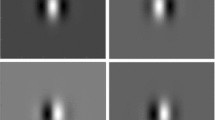Abstract
A model for monocular line perception by humanSs is based on three basic assumptions: (a) the line's inclination is coded by the maximally excited orientation detector's number; (b) the inclination of the perceived line is equivocally determined by the excitation vector in the subjective space; (c) the analyzer has a maximum differential sensitivity over the whole range of the line inclinations. This simple model for the line inclination analyzer, taking into account the optimization of its sensitivity, provides incomplex explanations for a wide range of psychophysical and neurophysiological data obtained from human and animal experiments.
Similar content being viewed by others
References
Artamonov, I.D.: Illusion of vision. Moscow: Nauka 1963 (in Russian)
Bishop, P.O., Henry, G.H.: Striate neurons receptive field concepts. Invest. Ophthalmol.11, 346–355 (1972)
Blakemore, C., Carpenter, R.H.S., Georgeson, M.A.: Lateral inhibition between orientation detectors in the human visual system. Nature228, 37–39 (1970)
Blakemore, C., Tobin, E.A.: Lateral inhibition between orientation detectors in the cat's visual cortex. Exp. Brain Res.15, 439–440 (1972)
Burns, D., Pritchard, R.: Geometrical illusions and response of neurons in the cat's visual cortex to angle patterns. J. Physiol. (London)213, 599–616 (1973)
Caldwell, J.H., Daw, N.W., Wyatt, H.J.: Effect of picrotoxin and strychnine on rabbit retinal ganglion cells, lateral interactions for cells with more complex receptive fields. J. Physiol. (London)276, 277–298 (1978)
Campbell, F.W., Maffei, L.: The tilt after-effect: a fresh look. Vision Res.11, 833–840 (1971)
Carpenter, R.H.S., Blakemore, C.: Interaction between orientations in human vision. Exp. Brain Res.18, 287–303 (1973)
Creutzfeldt, O.D., Ito, M.: Functional synaptic organization of primary visual cortex neurones in the cat. Exp. Brain Res.6, 324–352 4 (1968)
Fomin, S.V., Sokolov, E.N., Vaitkevičius, H.H.: Artificial sensory organs. Moscow: Nauka 1979 (in Russian)
Fries, W., Albus, K., Creutzfeldt, O.: Effects of interacting visual patterns on single cell responses in cat's striate cortex. Vision Res.17, 1001–1008 (1971)
Gibson, J.J.: Adaptation, after-effect and contrast in the perception of curved line. J. Exp. Psychol.16, 1–13 (1933)
Hoffman, K.-P., Morrone, C.M., Reuter, J.H.: A comparison of the responses of single cells in the LGN and visual cortex to bar and noise stimuli in the cat. Vision Res.20, 771–777 (1980)
Hubel, D.H., Wiesel, T.N.: Receptive fields of single neurones in the cat's striate cortex. J. Physiol.148, 574–591 (1959)
Ketleris, J.J.: Detection of a moving object by neurons in the rabbit's striate cortex. Cand. Sc. Diss., Pavlov Inst. Physiol., Leningrad (1979) (in Russian)
Lindsay, P.H., Norman, D.A.: Human information processing. New York, London: Academic Press 1972
Maffei, L., Fiorentini, A.: Retinogeniculate convergence and analysis of contrast. J. Neurophysiol.35, 65–72 (1972)
Magnussen, S., Kurtenbach, W.: Adapting to two orientations: disinhibition in a visual after-effect. Science207, 908 (1980)
Palmer, L.A., Davis, T.L.: Receptive-field's structure in cat striate cortex. J. Neurophysiol.46, 260–276 (1981)
Phelps, R.W.: Effects of interactions of two moving lines on single unit responses in the cat's visual cortex. Vision Res.14, 1371–1375 (1974)
Sekular, R., Littlejohn, J.: Tilt after-effect following very brief exposures. Vision Res.14, 151–152 (1974)
Sillito, A.M.: Modification of the receptive field properties of neurons in the visual cortex by bicuculine, a GABA antagonist. J. Physiol. (London)239, 36–37 (1974)
Sillito, A.M.: The effectiveness of bicuculine as antagonist of GABA and visually evoked inhibition in the cat's striate cortex. J. Physiol. (London)250, 287–304 (1975)
Vaitkevičius, H.H., Domijonaitis, A.P., Meškauskas, A.J., Sinius, J.J.: Apparatus for feature extraction from images. Proc. All-Union Conference on Robots, Toliatti (1975) (in Russion)
Yarbus, A.L.: Eye movements and vision. Moscow: Nauka (1965) (in Russian)
Author information
Authors and Affiliations
Rights and permissions
About this article
Cite this article
Vaitkevičius, H., Karalius, M., Meškauskas, A. et al. A model for the monocular line orientation analyzer. Biol. Cybern. 48, 139–147 (1983). https://doi.org/10.1007/BF00318081
Received:
Issue Date:
DOI: https://doi.org/10.1007/BF00318081




